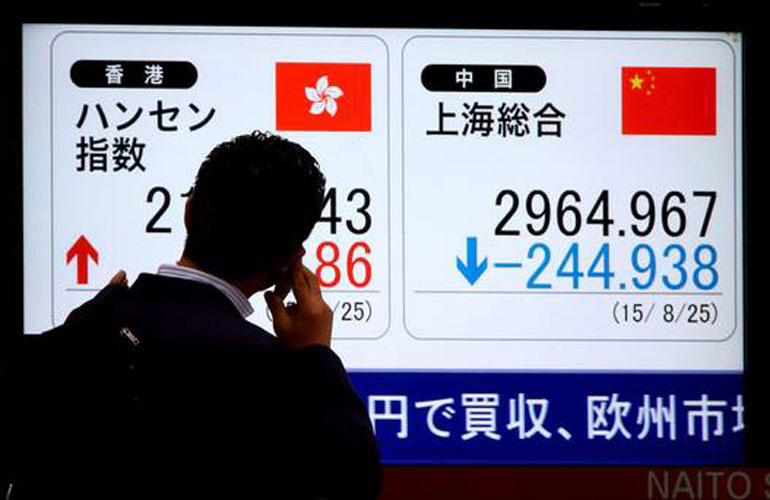Thursday Mar 13, 2025
Thursday Mar 13, 2025
Saturday, 9 January 2016 00:00 - - {{hitsCtrl.values.hits}}

Reuters: Asian shares rebounded on Friday, led by strong gains for battered Chinese stocks after China suspended its market circuit breaker system and set a firmer midpoint rate for yuan trading for the first time in nine days.
The improved sentiment looks unlikely to spill over into Europe, however, with financial spreadbetters expecting Britain’s FTSE 100 to open flat, and Germany’s DAX and France’s CAC 40 to start the day 0.5% lower.
Shares in Asia were still on track for their biggest weekly fall in more than four months, but Friday’s advances seemed to reduce some of the fears that have hit global markets.
China announced late on Thursday that it suspended its new stock market circuit breaker introduced only on Monday as the system failed to reduce market volatility, with some market players even saying it backfired.
The CSI300 index of major Shanghai and Shenzhen stocks was up 2.7% and the Shanghai Composite climbed 2.6%.
The gains pared losses for the week for both indexes to less than 10%.
Higher Chinese stocks also supported MSCI’s broadest index of Asia-Pacific shares outside Japan, which erased earlier losses to be up 0.5%. That put it on track for a decline this week of about 6%, which would be its biggest fall since August.
The People’s Bank of China (PBOC) also helped soothe markets by setting a stronger yuan midpoint rate against the dollar.
It set the rate at 6.5636 per dollar prior to market open, firmer than both the previous fix and Thursday’s closing quote. The spot market opened at 6.5700 per dollar, and was trading at 6.5889 at 0627 GMT.
The Chinese central bank on Thursday wrong-footed traders by reportedly intervening heavily to defend the yuan in offshore trade, reversing a decline of more than 1% that took it to a record low of 6.7600 per dollar.
The PBOC’s Friday setting is “a signal it does not intend to keep allowing the yuan to fall,” said Yoshinori Shigemi, global market strategist at JPMorgan Asset Management.
Japan’s Nikkei surrendered earlier gains to end the day down 0.4% at its lowest closing price since Sept. 30. That extended losses for the week to 7%, the biggest weekly decline in four months.
Wall Street also had a gloomy session, with the S&P 500 losing 2.4% on Thursday, with 40% of the stocks in the benchmark trading 20% or more off of their highs, the definition of a bear market.
That was despite a drop in layoffs and the number of Americans filing for jobless benefits, pointing to a strong December employment report on Friday.
However, weak data on U.S. manufacturing, construction spending, auto sales and export growth prompted economists to slash their fourth-quarter GDP growth estimates by as much as one%age point to as low as a 0.5% annual pace. The economy grew at a 2% annual rate in the third quarter.
After the U.S. market close, two Apple suppliers added to growing worries about slowing shipments of iPhone 6S and 6S Plus by cutting their revenue estimates for the third quarter.
The Chinese moves offered a leg up to oil futures, with both Brent crude and U.S. oil rallying more than 2%.
Brent gained 2.2% to $34.49 after touching $32.16 on Thursday, the lowest since April 2004. The gains narrowed losses for the week to 7.5%.
West Texas Crude advanced 2.1% to $33.98, on track for a weekly loss of 8.3%.
The shaky risk appetite seen this week sent investors flocking to low-risk assets such as bonds, gold and traditional safe-haven currencies, although that demand eased slightly on Friday.
The 10-year U.S. Treasuries’ yield fell to a 2 1/2-month low of 2.119% on Thursday and last stood at 2.1720%.
Gold eased back to $1,103.45 after earlier rising to $1,112, the highest since Nov. 4. That brought gains for this year to 4%.
The yen pulled back from Thursday’s 4 1/2-month high of 117.33 yen, last trading at 118.35 yen. The euro slipped 0.5% to $1.0880.
The Australian dollar, often used as a liquid proxy for China trade, strengthened to $0.7055 after falling to a three-month low of $0.6981 on Thursday. It’s down 3.1% this year.
Discover Kapruka, the leading online shopping platform in Sri Lanka, where you can conveniently send Gifts and Flowers to your loved ones for any event including Valentine ’s Day. Explore a wide range of popular Shopping Categories on Kapruka, including Toys, Groceries, Electronics, Birthday Cakes, Fruits, Chocolates, Flower Bouquets, Clothing, Watches, Lingerie, Gift Sets and Jewellery. Also if you’re interested in selling with Kapruka, Partner Central by Kapruka is the best solution to start with. Moreover, through Kapruka Global Shop, you can also enjoy the convenience of purchasing products from renowned platforms like Amazon and eBay and have them delivered to Sri Lanka.
Discover Kapruka, the leading online shopping platform in Sri Lanka, where you can conveniently send Gifts and Flowers to your loved ones for any event including Valentine ’s Day. Explore a wide range of popular Shopping Categories on Kapruka, including Toys, Groceries, Electronics, Birthday Cakes, Fruits, Chocolates, Flower Bouquets, Clothing, Watches, Lingerie, Gift Sets and Jewellery. Also if you’re interested in selling with Kapruka, Partner Central by Kapruka is the best solution to start with. Moreover, through Kapruka Global Shop, you can also enjoy the convenience of purchasing products from renowned platforms like Amazon and eBay and have them delivered to Sri Lanka.